|
|
|
|
The principals relating to the interaction of a magnetic
field on a moving electric charge passing through the field. |
|
Why does scale form and what is scale
Scale crystals, for example diamagnetic mineral salts such as
calcium carbonate (calcite), carry a charge. Scale deposition is a result of attraction between electrical
charges which concentrate on the sharp edges of the scale crystals.
The sharper the edges the stronger the charge and the larger the crystal and the stronger the crystal bonding.
Scale deposition is not a chemical
problem but an electrical problem. Obviously an electrical
solution is the logical approach to reduce or prevent crystal
bonding (scale deposition).
Scale-X applies scientific principles to treat and eliminate scale.
The Scale-X fluid
conditioning technology is based on the principles which relate to
the interaction between a magnetic field and the charge on the
scale crystals as the fluid passes through the magnetic field.
The same principals are used in electric generators, that is,
the interaction between a magnetic field and a metallic
conductor (coil) passing through the field which causes an
electric current (electric charge) to flow through the
conductor.
Not so well known is the effect of a magnetic field on a fluid
flowing through the magnetic field. The American Petroleum
Institute (API) funded the Baylor University Department of Chemistry to evaluate the principles of magnetic water treatment.
The resulting Baylor University technical paper
which was released at the 45th Annual Meeting of the
International Water Conference in 1984 stated,
"A fundamental
law of physics states that the motion of a conductor through a
magnetic field will cause a voltage to be produced. This
principle of electromagnetic induction was first demonstrated by
Faraday, and applies not only to conducting solids such as
wires, but also to conducting fluids such as aqueous solutions
containing dissolved electrolytes.
Magnetic flowmeters provide a well-known application of the generation of a potential using a conducting liquid."
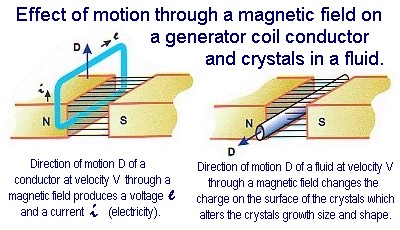
The Periodical Advanced Materials Research (Volumes
591 - 593) in the article entitled Influence
of Magnetic Field on Aqueous NaCl Solutions
by Mssrs: Hai Bo Han, Bin Guo and Feng Chai
the influence of magnetic field on the
aqueous solutions of NaCl studied by molecular dynamics (MD) -
the results show that, under the influence of magnetic field,
the hydration number of Cl- ions increases and the mobility of
hydrated Cl- ions is weakened, while the mean size of water
clusters decreases and the mobility of water molecules is
enhanced. This shows that a magnetic field can effect
significant changes in the formation of, and the
mobility of crystals and water molecules in an aqueous solution containing
the diamagnetic mineral salt sodium chloride NaCl, (or
containing any other diamagnetic mineral or organic salt) .
Professor John Donaldson and Dr. Sue
Grimes of the Chemistry Department of the City University,
London have conducted research into the effects of magnetic
fields on flowing fluids. They have stated,
"A magnetic field
will interact with any substance that carries a charge, however
small in any fluid. The nuclei on which the crystals start
growing and the growing crystallites are very small and will
have charged surfaces. As they pass through the magnetic field,
these charged particles encounter considerable forces as the
magnetic field interacts with them. The magnetic field acts at
the surface of the crystallites modifying the nature of the
charges at the surface. This alters the growth of the crystal in
general and on specific planes."
The observable effects of applying Scale-X MFCs .
The following information comes from years of industrial
applications of Scale-X MFCs and research in the Royal Melbourne
Institute of Technology University.
The effect of the magnetic field (correctly applied) on the
growing scale crystals results in the formation of significantly
smaller crystals with rounded and not sharp edges. The charge on
the surface of these crystals is significantly less than without
magnetic treatment as it is spread over the whole crystal
surface and not concentrated at a sharp edge..
These small crystals
are non-molecular bonding and have a tendency against
depositing as scale on the walls of the tubes and vessels,
leaving their surfaces continually clean.
[The term
non-molecular bonding
used in this web site refers to crystals that have a very weak
bonding capacity due to their very small size and weak charge OR
a severely weakened bonding capacity resulting from reduction in
size of the crystal and its charge and/or a more dispersed
distribution of the charge over the crystal surface OR both.
These crystals tend not to adhere to the walls of vessels and
pipes surface.]
It is important to note that there is no change in
the chemistry of the solution, only a change in the structure of
the crystals and strength of the charge.
For more details refer to the
accompanying technical papers and journal articles
one,
two and
three
With chemical treatment the plant still requires regular
cleaning.
The chemical dosing/solution tries to blanket the concentrated
electrical charge to stop crystal bonding by overlaying the
charge with a polymer. This is like a
medication which seeks only to treat the symptom but not the
cause - the Patient remains ill and still requires
ongoing medical treatment..!!!
Chemical
scale inhibitors do not stop scale formation and the plant still
requires regular ongoing cleaning/de-scaling.
|
|
Inorganic diamagnetic scale |
|
In the case of calcite, an inorganic
scale, this interaction modifies the charge on the crystals
which results in changes to the structure of the scale crystals,
both in shape and size, as demonstrated in the
photos by Dr Kronenberg of the California State Polytechnic University
and
Kronenberg lecture notes Q5 answer.
Instead of forming the normal large prism-shaped scale crystals
with sharp edges which have strong molecular bonding tendencies,
very small crystals are formed with rounded edges. These small
crystals are non-molecular bonding and have a tendency against
depositing as scale on the walls of the tubes and vessels,
leaving their surfaces continually clean. The treated
crystals remain in the flowing fluid / water and settle out at
low velocity points such as the basin of cooling towers.

Size of
untreated scale crystals - verses - size of treated scale
crystals
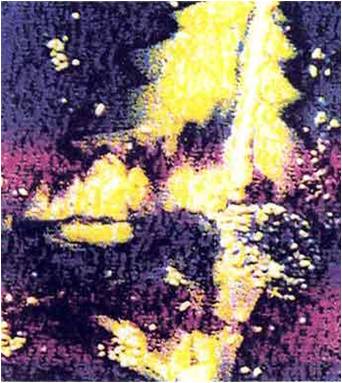
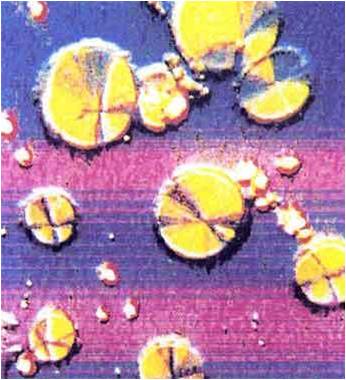
Untreated water
Magnetically treated water
(Magnified 1100 times)
(Magnified 1100 times)
|
|
Organic diamagnetic scale |
|
The following photographs are taken from the
Society of Petroleum Engineers International technical paper
SPE 38990 and shows the much smaller paraffin crystals which
form when treated with magnetic fields.
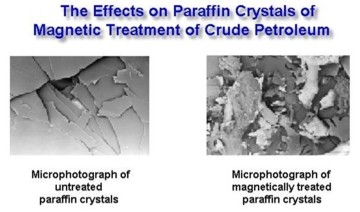
In the case of
organic scale, this change in the shape and size of magnetically treated
crystals has been recorded by electron microphotographs and an example is the
effect on paraffin as shown above. Again it is to be noted that paraffin forms
much smaller crystals as is also shown in the accompanying
logarithmic scale graph. Similar to calcite above, these small inorganic
crystals are non-molecular bonding and have a tendency against depositing as
scale on the walls of the tubes and vessels, leaving their surfaces
continually clean. |
|
The
following are some of the observable changes that magnetic fluid
treatment of fluids produces. Various examples of these are
contained in the accompanying technical reports and papers and
industry journals
one,
two,
three and
four.
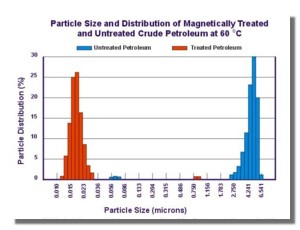
Enlarge
When crude
petroleum at 60ΊC is magnetically
treated the size of the treated paraffin crystals is 0.004 the
size of untreated paraffin crystals.
Magnetic fluid conditioning observable changes:-
It alters the scale crystallisation process. Treated
scale forming crystals have a
different structure and are
much smaller in size.
Treated scale stays soft and settles out as a
sludge at low velocity points.
Untreated scale crystals have sharp edges and
therefore strong bonding and magnetically treated crystals have
rounded edges and therefore no-molecular bonding.
Surface tension of water is approximately 10%
lower.
Viscosity of crude petroleum is lower and flows
easier.
Changes in crystallinity.
Changes in crystal morphology
Changes in solubility
Changes in rate of precipitation
X-ray diffraction patterns of treated and
untreated scale show a change in the chemical phase of the
precipitates.
Treated scale crystals are non-molecular
bonding and have a tendency against depositing as scale on the
walls of the tubes and vessels, leaving their surfaces
continually clean.
Existing scale is removed over time.
Scale and sludge settles out of the fluid
easier and quicker at points of low velocity resulting in a
reduction or elimination of the nutrients on which bacteria and
algae live.
Biofilm (slime) in air-conditioning an other cooling
tower systems can be eliminated resulting in the control and elimination of the Legionella danger
as outlined in
Maintenance Australia
- January 1990.
(Note that the terminology "Magneto Hydrodynamics" is another one of the names used for magnetic water
treatment and/or magnetic fluid conditioning)
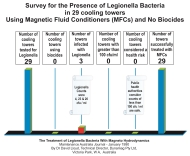
Enlarge Magnetic fluid conditioning
eliminated
the Legionella
problem in all 29 cooling towers
without the use of biocides.
|
|
Tuning the MFCs and the fluid system |
|
All technologies have an operating range of
parameters within which they function. Similarly, for magnetic
fluid treatment to function, certain parameters must be within a
defined range of operating values. Therefore the MFCs must be
tuned to the fluid system parameters. However, in many
applications it is necessary to modify the fluid dynamics while
in transit through the MFC's to bring them within a range of
values that the MFC can be tuned to. Scale-X MFC's are designed
on the
governing parameters of
Scale-X fluid conditioning technology and
incorporate these functions, and where necessary, incorporate
flow profiling and velocity amplification.
Factors that determine the operational effectiveness of magnetic
fluid treatment that must be taken into account and incorporated
into the design tuning process are:-
Magnetic field strength
Magnetic field structure
Magnetic field penetration and density
Velocity of the fluid
Fluid turbulence
Proximity to magnetic fields, electric motors
and pumps
Fluid flow profile
The intersection of fluid flow/velocity vector
and magnetic field gradient
Duration of the time the fluid remains in the
magnetic field
Concentration levels of the fluid
The magnetic susceptibility of the fluid
Conditions determining rate of scale formation
Fluid process system temperature and pressure
differentials
The pH level of the fluid
The energy for magnetic fluid treatment to work comes from the
momentum of the flowing fluid, in other words, from the pump.
This is the same as for a generator to produce electricity, the
energy to produce the current comes form the turbine driving the
generator. The energy does not come form the magnetic field in
either case.
Permanent magnets will perform at full capacity for decades.
However, the size, shape and materials used in permanent magnets
vary greatly. Thus the field structure, strength, density and
ability to penetrate the flowing fluid varies greatly. The type
of permanent magnets used in each application must be carefully
selected to ensure maximum benefits.
 |
|







